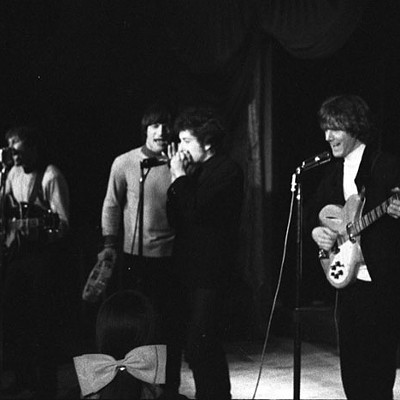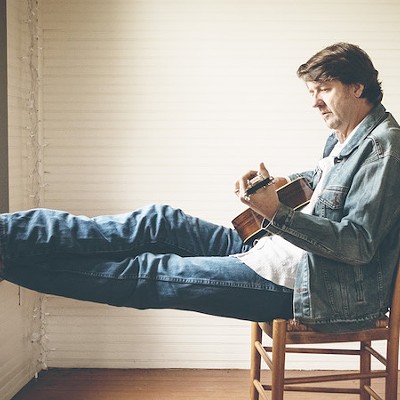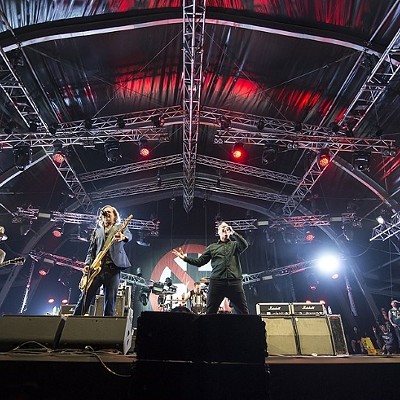Adam P. Newton recently became a father for the first time, so he has decided to explain the entirety of post-WWII Western pop music to his new daughter, “Fig”...one genre at a time.
Hey there, Fig. For the next stop in our musical journey, we’re heading back to the early 20th century to explore traditional folk and blues music. Along with gospel, nearly every genre of Western pop music can be traced back to these two. This was the music of the oppressed, the dispossessed, the woebegone, the have-nots and the never-would-haves. These songs came from the plantation, off the sharecropping farms and out of deepest Appalachia, touching on life, love, faith, hurt, heartbreak, pain, redemption, hope and everything in between.
So, let’s explore a few of the most important people who created these foundational musical forms. And unlike many of the people making music today, myth and legend make regular appearances.
ROBERT JOHNSON, CROSSROAD BLUES”
Johnson allegedly earned his legendary guitar chops thanks to a Faustian “deal with the devil” made at the crossroads. As one of the first members of “The 27 Club,” his influential recordings only come from a couple years of his life, yet he basically created the Delta blues, directly impacting the careers of B.B. King, Eric Clapton and nearly all subsequent blues rockers. One of the more iconic tracks in rock music history, “Crossroad” features Johnson’s caterwauling tenor, effortless licks, and a pleading style that would come to define much of the blues.
BLIND LEMON JEFFERSON, “SEE THAT MY GRAVE IS KEPT CLEAN”
Known by some as the “Father of Texas Blues,” Jefferson actually was born blind at birth. He directly influenced the next two folks on our list, especially his strumming style, as it blurred the line between Delta blues and country inflection. What’s saddest about this specific song is how prescient it was: after passing away from a heart attack in 1929, his grave laid unmarked for nearly 40 years.
LEADBELLY, “GOODNIGHT, IRENE”
This gentleman toured a bit with Blind Lemon Jefferson before landing in jail a few times. He didn’t achieve any notoriety until he was recorded by Alan and John Lomax. Yet, the first time I heard this song was thanks to Raffi in the mid-‘80s https://www.youtube.com/watch?v=RIfV0oSEWMI. It wasn’t until I started exploring blues and folk music after college that I realized the true origins of this lovely tune.
LIGHTNIN' HOPKINS, “T-MODEL BLUES”
Hailing from right here in Houston, Hopkins lived much longer than most of his contemporaries. Like most bluesmen of his generation, his style was birthed from lots of itinerant touring as a solo artist, so his licks often reflect bass lines, rhythm-guitar strums, lead runs, and percussive thumps. Compared to the other standouts of this era, I prefer the work of Hopkins, mostly because I dig his warbling tenor, his thinly veiled references to sex, and his overall picking style.
WILLIE MAE “BIG MAMA” THORNTON, “HOUND DOG”
Remember hearing your Granddaddy talk about how great Elvis Presley was? Let me introduce you to “Big Mama” Thornton. Not only did she record “Hound Dog” before Elvis, this bold, brash, and boundary-jumping artist brought a different energy to the world of blues music. Her take on this song possessed the sort of rambunctious grit that Elvis attempted to mimic his entire career. She was a certifiable badass whose personality and swagger can be heard in the careers of Janis Joplin, Sharon Jones, Erykah Badu, and more.
B.B. KING, “THE THRILL IS GONE”
While King didn’t start playing until most of the other bluesmen on this list had passed away, he’s still the one most people think of when it comes to the blues. He truly brought the art form into the modern era and popularized it like no other, bringing a dramatic flair to how people performed and enjoyed the blues. With this tune, probably the best-known in his catalog, you’ll hear the ragged vocals of Jefferson, the lyrical chicanery of Hopkins, and the virtuosity of Johnson distilled to their absolute essence.
LYDIA MENDOZA, “MAL HOMBRE”
Here’s another strong woman who made music on her terms contrary to the cultural milieu of the time. Mendoza brought Tejano — initially a mix of traditional Mexican folk tropes with the polka “oom-pah” of the Central Texas European immigrants — into wider recognition the ‘30s with this song. Her clear alto voice pared well with her strong guitar strumming, something she held in common with Mother Maybelle and her daughters, the Carter Sisters https://www.youtube.com/watch?v=ewnfWoSQz3o.
THE CARTER FAMILY, “CAN THE CIRCLE BE UNBROKEN”
The first family of folk, The Carter Family toured relentlessly, merging gospel with country and bluegrass, which helped bring all three into popular consciousness. What I like most about this song are the strong three-part harmonies, uplifting lyrics, and the overall sing-ability of the tune. Mother Maybelle Carter also had a unique pick-and-strum style of guitar playing - which is rather under-appreciated in terms of influence.
WOODY GUTHRIE, “THIS LAND IS YOUR LAND”
The father of modern American folk music, Guthrie remains idealized today for his leftist politics and troubadour spirit. Most folks only know the first verse of this song: the melody is bright, the chord progression is easy for beginning guitar players to mimic, and the words are overtly patriotic. However, when you examine the seven full verses, you’ll see that the song is rather anti-capitalist in spirit - and Guthrie’s song usually featured the phrase “This machine kills fascists.”
PETE SEEGER, “IF I HAD A HAMMER (THE HAMMER SONG)”
The thematic successors to Guthrie, Seeger’s tunes were sprightly and friendly, mostly major key in arrangement, and designed to be sung by large crowds. In fact, Seeger's corpus includes “Turn, Turn, Turn,” “Where Have All the Flowers Gone,” a cover of “Goodnight, Irene,” and the popularizing of “We Shall Overcome” during the American Civil Rights movement. So, why did I choose a song about a hammer? Because it combines a fun folk tune with lyrics about bringing love, freedom and justice to the oppressed of this world.
BOB DYLAN, “BLOWIN' IN THE WIND”
With Mr. Zimmerman, folk music arrives in its own modern era. Like B.B. King and the blues, Dylan took the best and brightest ideas of his preferred genre, polished them up a bit, and inserted his own genius. In the last years of his life, Guthrie directly mentored Dylan, who had moved to Greenwich Village in an attempt to locate the influential Okie. With this classic tune, Dylan marries warbling harmonica, simplistic chord changes, and his trademark reedy vocals to lyrics that have impacted 50-plus years of disaffected and troubled youth.
So, do you hear some similarities between the children’s music in our first installment and the men and women who birthed folk and the blues? Sure, the lyrical content definitely isn’t the same, but you should recognize some familiar chord progressions and melodic arrangements. Like I said in the beginning, without them, Western pop music wouldn’t be what it is today.
Next: the fundamentals of country music.
Support Us
Houston's independent source of
local news and culture
account
- Welcome,
Insider - Login
- My Account
- My Newsletters
- Contribute
- Contact Us
- Sign out
[
{
"name": "Related Stories / Support Us Combo",
"component": "11591218",
"insertPoint": "4",
"requiredCountToDisplay": "4"
},{
"name": "Air - Billboard - Inline Content",
"component": "11591214",
"insertPoint": "2/3",
"requiredCountToDisplay": "7"
},{
"name": "R1 - Beta - Mobile Only",
"component": "12287027",
"insertPoint": "8",
"requiredCountToDisplay": "8"
},{
"name": "Air - MediumRectangle - Inline Content - Mobile Display Size 2",
"component": "11591215",
"insertPoint": "12",
"requiredCountToDisplay": "12"
},{
"name": "Air - MediumRectangle - Inline Content - Mobile Display Size 2",
"component": "11591215",
"insertPoint": "4th",
"startingPoint": "16",
"requiredCountToDisplay": "12"
}
,{
"name": "RevContent - In Article",
"component": "12527128",
"insertPoint": "3/5",
"requiredCountToDisplay": "5"
}
]
KEEP THE HOUSTON PRESS FREE...
Since we started the Houston Press, it has been defined as the free, independent voice of Houston, and we'd like to keep it that way. With local media under siege, it's more important than ever for us to rally support behind funding our local journalism. You can help by participating in our "I Support" program, allowing us to keep offering readers access to our incisive coverage of local news, food and culture with no paywalls.
Adam P. Newton
Contact:
Adam P. Newton
Trending Music
- Country Rock Thrives with Gene Clark and Flying Burrito Brothers for Record Store Day
- Low Cut Connie Keeps One Foot In The Gutter
- Bruce Robison Is The Eternal Song Hunter
-
Sponsored Content From: [%sponsoredBy%]
[%title%]

Don't Miss Out
SIGN UP for the latest
Music
news, free stuff and more!
Become a member to support the independent voice of Houston
and help keep the future of the Houston Press FREE
Use of this website constitutes acceptance of our
terms of use,
our cookies policy, and our
privacy policy
The Houston Press may earn a portion of sales from products & services purchased through links on our site from our
affiliate partners.
©2024
Houston Press, LP. All rights reserved.




